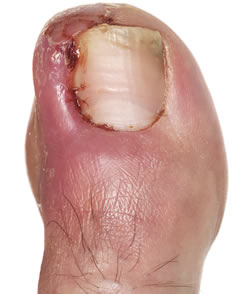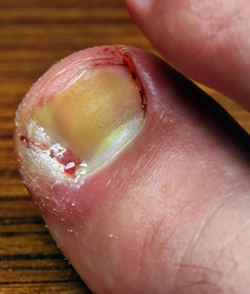Patient Education
Ingrown Toenails
An ingrown toenail (Onychocryptosis) is a common condition in which the corner of the toenail grows into the skin or the skin grows over the nail causing pain and swelling. Ingrown toenails most commonly affect the big toes, although any toe can be affected.


Cause
• Ingrown toenails result from wearing high heels or shoes or socks that are too tight. Compression stockings have been known to cause ingrown toenails.
• Rounded nails or nails cut too short can lead to an ingrown toenail. Toenails should be trimmed straight across.
• Some medical conditions such as fungal infections or arthritis can cause toenails to thicken and grow abnormally.
• Ingrown toenails can result from injury. Soccer players frequently develop ingrown toenails.
• Congenital. Some people are born with nails that are curved and grow downward, or the toenail may just be too large for the toe.
Symptoms
• Pain and tenderness in the toe along one or both sides of the toenail
• Redness
• Swelling
• Increased warmth to the toe
• Pus or drainage
Treatment
In some cases, ingrown toenails can be treated at home. You should soak your toe in warm water several times a day. Over-the-counter products such as an antibiotic ointment can help reduce the swelling and promote healing. Protect your toe with a soft foam toecap or gauze. As your toenail grows out, trim it straight across.
If you have a medical condition that puts you at risk for infection, such as diabetes, poor circulation, or AIDS, you should not treat ingrown toenails at home. You should contact a podiatrist immediately for professional treatment. Anyone that is not getting results with home treatment or suspects that they have an infection should also contact a podiatrist.
If left untreated, ingrown toenails can become infected. Infections can lead to abscesses that require surgery. Infections are especially concerning for people with diabetes, poor circulation, and AIDS, or those receiving chemotherapy
A podiatrist can professionally trim or correct an ingrown toenail in his or her office. Your doctor can safely remove excess skin around the toenail. He or she can prescribe antibiotics to prevent infection. In severe or recurring cases, a permanent procedure can be performed.
Prevention
• Trim toenails straight across
• Keep toenails at a moderate length. Do not cut toenails too short
• Wear shoes and socks that fit well
• Keep feet clean and dry


